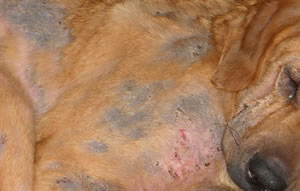
Mange
What is mange?
Symptoms of mange
Diagnosis of mange
Prevention / remedies / cures / treatment for mange
What is mange?
Mange is a skin disease caused by mites, that affects non-human mammals. In humans, the two most common types of mite infections that would be called "mange" in furry mammals, are instead known as scabies and demodicosis.
These parasitic mites embed themselves in either the skin or the hair follicles of the animal. The genus Sarcoptes burrow into the skin, while Demodex live in hair follicles. In a case of mange, these mites dilate the hair follicles (and sweat glands, if they exist) in the skin. The mites may carry and introduce the bacterium Staphylococcus epidermidis, which also cause the mange.
Dog mange is usually caused by Sarcoptes scabiei canis. This particular mite can also infest cats, pigs, horses, sheep and various other species. Humans are normally infected by the closely-related sub species Sarcoptes scabiei hominis that causes scabies. However, visitors to Grow Youthful report numerous cases of dreadful long-term mite infections of pet-owners, particularly dog and bird owners. All kinds of mites can pass from animals to humans, especially if a person's immune system is weakened and their resilience is not strong.

Symptoms of mange
- Intense itching.
- Poor coat condition.
- Loss of fur.
- Dog's feet may be swollen or irritated, particularly around nail beds.
- Crusting.
- Eventually, poor condition, immune suppression, starvation, death.
Hair loss and crusting usually first appear on the animal's elbows and ears. As the mange advances, skin damage can occur from the dog's intense scratching and biting. This self-caused damage opens the skin to secondary infections. The secondary infections can spread throughout the animal, causing it to be seriously ill and eventually die.
Diagnosis of mange
A simple way of determining if a dog has mange is if it moves one of its hind legs in a scratching motion when you gently scratch and manipulate its ear. This is because mites proliferate on the ear margins in nearly all cases and the dog develops a scratching reflex.
Mange is usually diagnosed by taking skin scrapings from multiple areas on the animal, and examining them under a microscope. The mites may be hard to see because the dog can remove a lot of them by chewing at their skin.
Prevention / remedies / cures / treatment for mange
Animals infected with mange should be isolated from other animals and their bedding, and places they have occupied must be thoroughly cleaned. Dogs and other animals in contact with a diagnosed case should be evaluated and treated.
Borax - hydrogen peroxide solution for treating dogs
Put 3 rounded tablespoons of borax in a clean bucket. Add three cups of hot water, and stir until all the borax is dissolved. Add two cups of tepid water. Gently stir in two cups of 3% hydrogen peroxide. Set aside to use after your dog has been washed and rinsed. You can buy H2O2 at hardware stores, supermarkets and some pharmacies. It does not have to be food grade. Ensure it is 3%, NOT a different concentration.
Next, shampoo your dog using a quality dog shampoo. Do not use shampoo made for humans, as it has different pH, oil and skin effects. After shampooing, double rinse with water to remove all the shampoo.
Slowly apply the borax-peroxide solution you just made, using a plastic cup. Apply the solution to every part of the dog, including areas not affected by the mange. Fully saturate the entire animal. To treat the animal's face, pour a little solution into the palm of your hand and gently apply. Gently massage the solution into the dog's skin. It is important to treat the paws, getting in between the pads and claws.
Do not massage the solution into broken skin, sores or bleeding areas. Simply gently apply it to that area.
Do NOT rinse off the solution. Do not towel dry, unless you have to because it is very cold.
For the first week, treat the dog every second day. You should see an improvement in the mange after the first few days.
For the second week, give the treatment every three days.
For the next few weeks, treat once per week. After a couple more weeks, you can treat twice per month.
It is important to treat a few more times even after the mange seems to have completely cleared up, because eggs may still be residing in the skin.
Each time you treat the dog with the solution, also wash its bedding, sleeping place and towels you used in hot water with 1 cup of borax. Dry in a dryer on the highest setting. You can clean the dog's sleeping area and any floors it inhabits by spraying with the above borax-peroxide solution.
If you use any remedies from Grow Youthful, please come back next week (or whenever you have an outcome) and let us know about your experience. Please leave a comment as many people are interested.
See details of remedies recommended by Grow Youthful visitors, and their experience with them.
